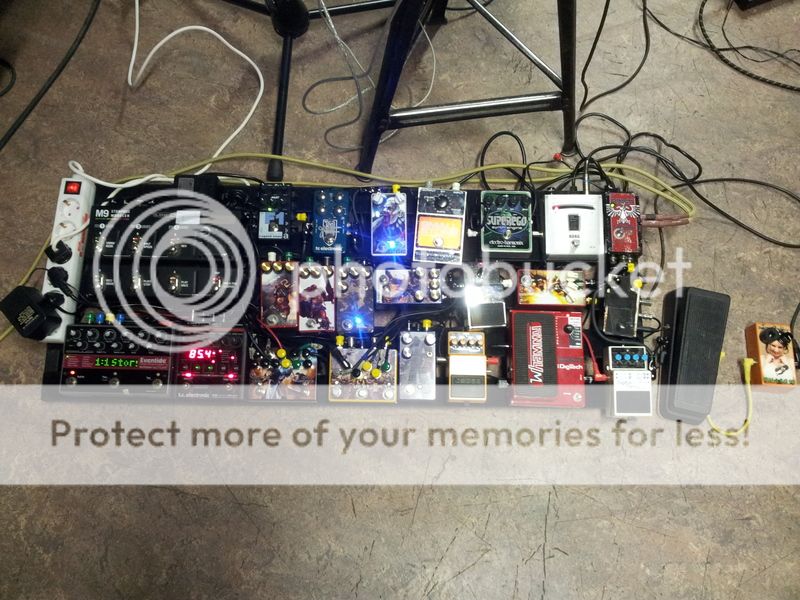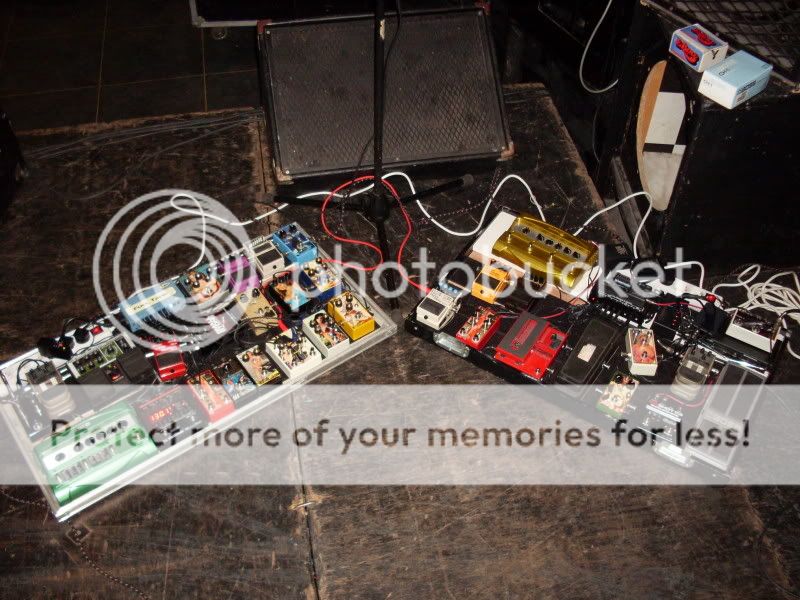That significantly simplifies things.

Since you're still in the process of finding out what you want it's probably best to keep some flexibility in mind and go for a smaller pedalboard, small enough to suit your current needs but still big enough to have some room for expension. When you start putting together a bigger pedal collection you could upgrade to a bigger board and if you want to sell your old one. If it's a pedaltrain you will still get some money for it. If its something you put together yourself and you try to sell it it's 2nd hand value may not be worth that much as you think, maybe not even worth the parts you paid for it to put it together. Such is the nature of selling DIY gear. People tend to go for brand name recognition, doesn't matter how well you put things together.
With your current setup I don't think you would need a looper just yet. I would advise going for a Pedaltrain Classic 2 and power it all through a Voodoolab Pedal Power 2 plus (from now on PP2+). This setup would be small enough to suit your needs until you figure out what you really want. Maybe you find this is all you really need in which case you're set anyway. Or you get something bigger, in which case you can keep the PP2+ and sell the board. The PP2+ has the advantage (other then being an industry standard cause it is just plain good) of being able to power all your current pedals, including the M5. Although you would need a current doubler adapter (part#PPAP) from Voodoolab to power the M5.
Adapter Cables, Voodoo Lab
The PP2+ can power up to 8 pedals, although the current doubler adapter would bring that down to 7. Small price to pay though for eliminating an adapter (clumsy lumbersome beasts!), thus easing logistics. Plus it would allow you to still power 3 additional pedals into your current setup. If need be you can get another power supply and connect it to the PP2+ as it also has a complementary output for another power supply. Also note that overdrives, fuzzes and distortions draw so little power you could easily power several of them using a small daisy chain from a single PP@+ outlet. So you can do more pedals then just the 7. If you want you can play around with the layout of your future pedaltrain pedalboard here:
PedalboardPlanner.com - Plan your Perfect Guitar Pedal Board!
The PP2+ can be mounted underneath the pedalboard using mounting brackets, which is superhandy as it frees up pedalboard space. Whenever I bought a pedaltrain board big enough to mount a powersupply underneath it it came with a set of mounting brackets and screws as well for a PP2+, again superhandy. Although the screws themselves were utter shit and I ended up throwing them away in favor of hex headed bolt screws from my local hardware store. For pedal train has come up with the 'brilliant'idea that you should drill some holes into the frame and just screw the philips headed screws in using a philips screwdriver. You try doing that with the recommended drill width and the screws will turn to mush within the first turn. Using screws with hex heads has the advantage that you can safely apply some force to screw them in. As a consequence of getting different screws I did have to enlarge the holes on the brackets a little to accomodate the new screws. Nothing you can't fix with a drill though.
P
edal Train also supplies two rolls of soft and hard velcro to put on your pedalboard and underneath your pedals. They're not the best though, so make sure the surface you stick them on is both cleaned and free of grease. And grease gets on very easily just by touching a surface with your hands. It doesn't hurt either to heat the velcro glue with a hair dryer before sticking them. It helps to bond the glue better. Give the velcro a few hours afterwards to settle though.
You can get a PT-2 as just the frame, or with a softcase or hardcase. I leave that choice up to you. For relatively small pedalboards softcases are perfectly fine. For larger ones I think hardcases are pretty much mandatory. Hardcases are also better if you need to travel by air as bagage handlers aren't necessarily always that careful whilst handling luggage. Minimum wage, you get what you pay for!
The hardcases also have a handy compartment inside for cables and stuff. I also use it to carry a spare power block, as you can never have to many cables and power blocks when going to a gig. Better to have it and not need it then to need it and not have it.
One of my little quirks is that I always build a little cable patchbay that I put on the top right of my pedalboard. The reason being that I want all my cables to enter and exit the board on that spot. I prefer to play on the right side of the stage (or stage left when viewed from the audience) so I want all my cables to be on my right side, that way I won't trip over them, as I do like to walk about during a gig. Which would the case as the cables leaving a pedalboard usually do so on the left side of the board. I also often include a stomp switch on my patchbay box so I can mute the board. Seems helpful right? Especially if you want to play something into the looper of your delay in silence to surprise the audience later. A trick Radioheads uses a lot. On the other hand you'd be surprised how often I forget that switch was on and was dumbfounded why I no longer had any signal!
Finally, while true bypass is a good thing it never hurts to have at least one buffered pedal in your signal chain, as a signal that has to travel through a series of TB pedals still loses some signal, and a buffer helps restore some of that lost sparkle. So, as with everything in life moderation is the key. Only buffered pedals is just as bad as only TB pedals. And some buffers are truly amazing. Both the Klon buffer and the Pete Cornish buffers have become legendary as they're supposedly sprinkled with fairy dust.
Finally a gratuitous selfindulgent shot of my current pedalboard, built on a Pedal Train 4, usually stored in a hardcase.
Unfortunately I could not eliminate that huge ass adapter from the Whammy as you cannot run it from the PP2+. You can from the Pedal Power AC, but to buy that one just for one pedal seems a bit much. Similarly the M9 also has special prima donna power requirements that necessitated keeping its adapter on the board. Note the patchbay box on the right top for cable connections. It also has a buffered signal splitter in case I want to run a separate signal chain, for shimmer for instance. There's a 2nd patchbay underneath that functions as a FX send/return loop, I usually insert a wah pedal in there if I want one.
Next to the nova delay in the bottom row are two loopers that I made. The right looper (yellow) has three mono loops, one that the whammy and an envelope filter, the middle selects between a loop which has my dirt boxes and noise gate, or a loop for clean sounds, and the 3rd has my modulation effects. The left looper (black) has two stereo loops. Which was incredibly hard to make as there don't seem to be any schematics for DIY stereo loops out there. I had to put two relay boards from THcustom.com in parallel to a single momentary switch. It works though plus it doesn't have the pops you sometimes get from mechanical true bypass switching. First loop controls the Eventide harmonizer, the other my Nova delay and M9, which I use for delays and reverb.
Most of the magic is underneath the board, which has 2 PP2+ power supplies, a PP Iso 5 power supply (which can power the Eventide), a T-Rex fuel tank power supply and a Line 6 wireless receiver




